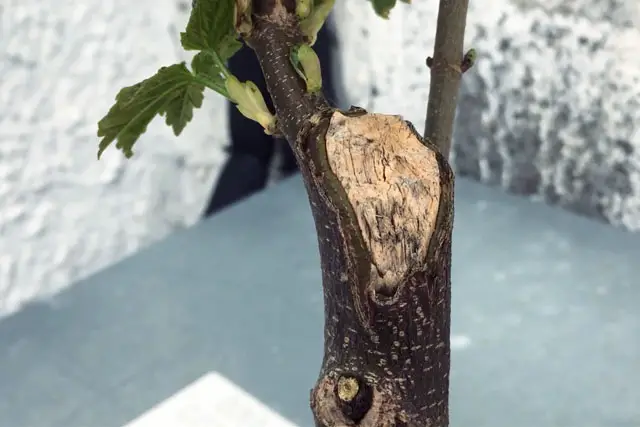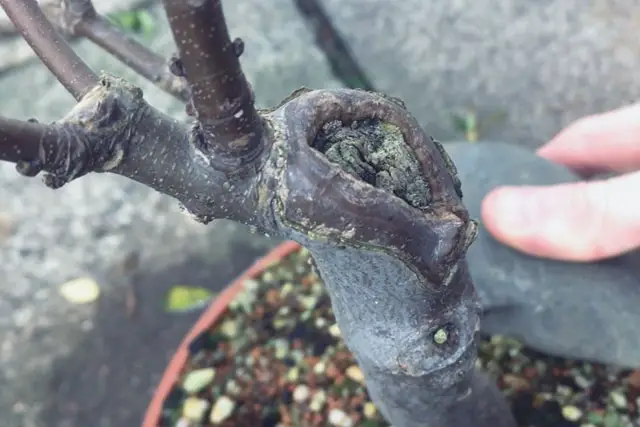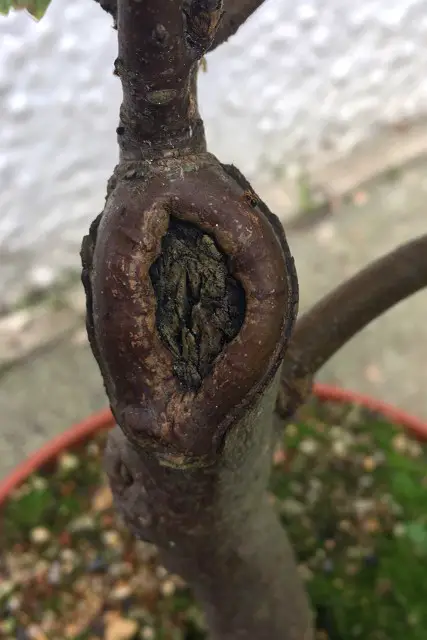Trunk chopping is exactly what it sounds like, we chop the trunk of a taller tree to reduce its height and give ourselves a strong foundation to build a bonsai from.
It’s a pretty drastic technique, but over the long term it can be a great way to build a bonsai from very basic material.
Page Contents
What Is Trunk Chopping A Bonsai?
Trunk chopping is a technique used to develop a bonsai, more specifically a thicker trunk on a tree. We take a tall, thick trunk and chop it down to a smaller size. Basically we reduce a tree down to a stump that might only be a couple of inches tall.
It sounds counterproductive and looks drastic, but when you read why we do it, it will make more sense. We can only do this technique on a deciduous tree as it will be able to regrow from a stump (You can read more about – Deciduous Tree Maintenance)
If you did this on a conifer it would die. You can still trunk chop a conifer, you just need to make sure you leave a living branch below where you cut, which will wired to become the new main structure of the tree.
Why Do We Do Trunk Chop Bonsai?
If we want to get a thicker trunk on a bonsai tree, the only way to do this is to let the tree grow really tall. The taller it gets, the thicker it will become. This is a problem for bonsai as we do not want a tree that is really tall, we want the thickness without the height. The only way to do this is to cut the tree back and simply chop the trunk.
This will usually leave you with just a stump, but depending on the thickness of the tree and what you are trying to achieve you can then let this grow new shoots, which you can allow to grow tall again and repeat this operation, or you can start to develop some branches and start to build your tree.

Balancing Between Thickness and Scars
trunk chopping is going to leave a big scar, but you can try and reduce this, by balancing when you decide to cut it back.
Some people will let their tree keep growing until it reaches the thickness they want, and then do a trunk chop. This is totally fine, but you will be left with a large scar.
At the other end of the scale you can let your tree grow for a shorter period of time and then chop it, even if it is not the final thickness you want.
If you do this, you then allow the tree to grow out for a while and then again cut it back. You can do this a number of times until your tree reaches the thickness you need. Doing it this way will take longer, but you will be left with a number of smaller scars, which are more likely to fully heal over and not be as noticeable as they are smaller.
You should also end up with some crazy movement in your trunk. Every time you do a trunk chop the new growth should change direction slightly, so you can build a tree full of character very easily by doing this.
You need to find the balance you are happy with. You need to balance out the thickness you want to let it reach, with what size of a scar it might leave, along with how long it might take to get to the trunk thickness you want by doing it in a number of steps.


(You can read more about – Healing Wounds On Bonsai Trees)
When Is Your Bonsai Tree Ready To Be Trunk Chopped?
As I have alluded to above, you need to decide when you feel it is right. There are no set rules for when you can or cannot do a trunk chop. Although there is a preferred time of year to carry it out, which I will discuss below.
All you need to do is make sure your tree is healthy, and then you can decide to do it when you feel it is the right thickness and it would benefit from it.
So long as you are aware the more often you do it, the longer it will take to thicken the trunk and on the opposite end of the scale, if you do it less, you may end up with a thicker trunk faster, but you will have a large scar to deal with.

If you are finding this article useful you should also check out my YouTube Channel, I post new video’s every Sunday.
I like to show each of my Bonsai trees journey throughout the year in a sort of time lapse, along with some tips and techniques throughout the video.
What Time Of Year Should You Trunk Chop A Bonsai?
Although your bonsai tree can be ready to trunk chop whenever you feel it is ready, it best to do the actual procedure at two times in the year.
Trunk Chopping In Winter
It is good to trunk chop a bonsai in very late winter, pretty much as spring is about to start.
At this time all the trees energy is stored in the roots and it is still dormant. This means you can remove a lot of the top growth safely and as soon as the tree wakes up in a few weeks it will send all its energy up from the roots and send new buds out all over the trunk you have left.
Trunk Chopping In Summer
In late spring into early summer, once the new foliage has hardened off, you can safely make large cuts to your bonsai.
At this time the tree is active, but it will not be moving water through the system as dramatically as spring. This means you can cut it back hard and will not cause the tree too much harm.
Doing this in early summer will make the tree act like it is spring again and will send out a new flush of growth. Also as it is actively growing at this time it should start healing itself right away.
Can You Repot A Bonsai After A Trunk Chop?
I would avoid doing a trunk chop and repotting at the same time and even in the same season. It’s best to keep the roots as strong as possible so they push out much new growth as possible on your bare trunk.
I know a few of you will have watched my videos and will be saying “but I’ve seen you do both in one season” this is true. I am happy to risk it as I know my bonsai trees are strong, all I’m saying is, if you are going to copy me, be careful.
How Do We Trunk Chop A Bonsai?
There is really not much to this technique. It is exactly as it sounds. You just chop the trunk. You can use a saw, loppers or even pruners if your trunk is small. Just use anything that will cut through the thickness of the tree you have.
All you need to do is take it right back to what you feel is right for the tree. Some people may go back to a full stump, some may leave a branch or two. It’s your bonsai tree and you are building it, so you can do what you feel happy with.
There are no real rules about how you do it. Some people just go for a flat cut; others may angle how they make the cut. It all depends on the individual tree and what you want to do with it.
(You can read more about – Pruning Bonsai Trees)
Trunk Chop Aftercare For Bonsai
Once you chop your trunk chop your bonsai you can apply cut paste if you want. This will help prevent further die back.
Mostly importantly you just need to let your bonsai tree grow. This is a very aggressive technique and you should let your tree adequately recover from this. The best way to let them recover is to let them grow out fully for the rest of the season.
Once your bonsai tree has regained vigour you can begin building your branch structure or prepare it for another trunk chop if you are still developing your trunk.
Precautions Before Trunk Chopping A Bonsai
Although I have said this will work with deciduous trees, you should double check that the species you own can be pruned in this way. You don’t want to do this, only to find out it’s killed your tree.
I would also make sure you know how your tree responds to pruning. If it dies back, you need to factor this in.
Some trees may die back an inch when you cut them (This is just to help explain the example, I don’t think any trees die back that extreme). So, if you want a 5 inch trunk, you will need to chop it 6 inches high, to allow for that 1 inch of die back.
Conclusion
Trunk chopping a bonsai is a really effective tool in building a thick trunk from scratch and it can help you reach your goals quite quickly. If you haven’t tried this yet I would highly recommend it, especially if you are growing bonsai trees from seed like I am.

Hi, I’m Ian. I have been doing bonsai since 2014. I created this site to spread all the knowledge I have acquired over the years. Don’t forget to check out my Youtube videos where I show the progress of my own Bonsai each week or connect with me on social media.
You can read more about me and how I got into Bonsai on the About Page


